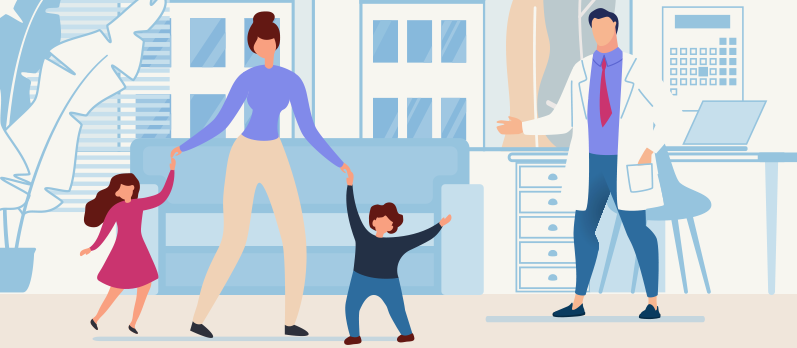What’s the Buzz
The Bee Healthy Blog
What Are the Best Cerebral Palsy Treatment Options?

Key Takeaways
-
Cerebral palsy (CP) is a group of neurological disorders that affect movement, balance, and posture.
-
Cerebral palsy is caused by infections or illnesses that cause damage to the developing brain before birth or within the first year of life.
-
The three types of cerebral palsy are spadtic cerebral palsy, dyskinetic cerebral palsy, and ataxic cerebral palsy.
-
While there is no cure for cerebral palsy, a comprehensive treatment plan can improve functioning and optimize the child’s health.
-
A combination of medications, therapies, surgeries, and lifestyle changes can help people diagnosed with cerebral palsy achieve a higher quality of life.
Cerebral palsy (CP) is an umbrella term used to describe a group of neurological disorders that affect movement, balance, and posture. Cerebral means related to the brain, and palsy means muscle weakness or overall problems with muscles. This condition occurs due to abnormal development of the brain or damage to the developing brain. Impairment in controlling muscle movement is the main effect of CP. Other parts of the brain may be affected, leading to seizures, speech impairment, problems with hearing or vision, or intellectual disability. The main thing to keep in mind is that CP symptoms vary among individuals, and having cerebral palsy does not mean a person will have an intellectual disability by default.
Treatment options for cerebral palsy include a comprehensive approach consisting of multidisciplinary health professionals working together to oversee the child’s condition. Generally, if your child is diagnosed with CP, they will still remain under the care of their pediatrician who coordinates treatments with different specialists, including neurologists, physical and rehabilitation specialists, and mental health professionals. The care team may include other healthcare specialists depending on the specific CP symptoms, for example, speech-language pathologists, occupational therapists, social workers, and surgeons. While CP cannot be cured, the symptoms can be treated with medications, different types of therapy, and surgeries. Please continue reading to learn more about cerebral palsy treatment.
What causes cerebral palsy?
Damage to the developing brain or abnormal brain development can happen usually before birth, during birth, within the first month after birth, or during early infancy, typically during the first year of the child’s life. Risk factors for cerebral palsy include infections and illnesses during pregnancy or infancy. Symptoms of cerebral palsy typically appear during early childhood and can vary as the child develops.
What are the types of cerebral palsy?
There are three types of cerebral palsy: spadtic cerebral palsy, dyskinetic cerebral palsy, and ataxic cerebral palsy.
The most common type of cerebral palsy is spastic cerebral palsy. It is associated with muscle stiffness, jerky muscle movement, and hyperactive reflexes. People with dyskinetic cerebral palsy have difficulty controlling voluntary movements. Those with ataxic cerebral palsy have problems with balance and coordination.
How is cerebral palsy diagnosed?
Severe CP usually becomes apparent in the first year of life. Mild CP may not be diagnosed until a child is older. Healthcare providers can make a CP diagnosis based on the child’s growth as well as the child’s symptoms, medical history, laboratory test results, brain scans, electroencephalogram (EEG), and tests for vision, hearing, speech, intellectual disability, and development.
Can cerebral palsy be cured or treated?
There is no cure for cerebral palsy. However, a child’s healthcare team can develop a comprehensive treatment plan to improve functioning and optimize the child’s health. Cerebral palsy symptoms may vary during the child’s development, though it does not get worse, and the overall condition generally stays the same over time. Keep in mind that even though CP does not get worse, the exact symptoms may change over the span of a person’s lifetime.
What is the best treatment for cerebral palsy?
Cerebral palsy is a lifelong condition that requires long-term medical care to improve function. A child with cerebral palsy usually has a care team that includes primary care providers, pediatric neurologists, physical medicine and rehabilitation specialists, physical and occupational therapists, speech therapists, and mental health specialists.
These experts develop a treatment plan for the child based on the type of cerebral palsy, the severity of the child’s condition and impairments, the location of the movement problems, and the child’s symptoms, issues, and other medical conditions.
Early intervention for cerebral palsy can improve functional abilities. The goal is to relieve pain, improve muscle tone, and enhance the child’s quality of life. Common treatments for cerebral palsy include medications, therapies, and surgical procedures.
How is cerebral palsy treated?
Medications for cerebral palsy
Various medications are used to improve functionality by reducing muscle tightness, treating pain, and managing the complications of cerebral palsy. Medications may include:
-
Oral muscle relaxants such as tizanidine (Zanaflex), baclofen (Fleqsuvy, Lyvispah, Ozobax), diazepam (Valium, Diazepam Intensol), and dantrolene (Dantrium) to relieve muscle spasms and tightness. In severe cases, baclofen may be given through an intrathecal pump that is implanted under the skin of the abdomen, and that puts the medicine directly into the spinal cord.
-
Muscle or nerve injections such as onabotulinumtoxinA (Botox) to reduce muscle tightening and manage symptoms like drooling or bladder control. These injections need to be repeated every 3 months.
-
Anticholinergics used to help with muscle tone, involuntary muscle movements, and excessive drooling, such as glycopyrrolate (Robinul), carbidopa-levodopa (Sinemet), benztropine mesylate (Cogentin), and trihexyphenidyl hydrochloride.
-
Other medications to treat CP-related symptoms: over-the-counter pain medications (Tylenol) and anti-inflammatory drugs (Aleve, Advil), anticonvulsants, antidepressants, and laxatives and stool softeners.
Therapies for cerebral palsy
Physical therapy
Working with a physical therapist can improve a child’s muscle strength, flexibility, balance, mobility, posture, muscle control, and fine motor skills. Physical therapists can also guide parents and caregivers on safety measures while caring for a child with cerebral palsy, including everyday tasks such as feeding and bathing. Early intervention with physical therapy exercises can help prevent complications like contractures (shortening and hardening of muscle and other tissues) and scoliosis (development of a sideways curve of the spine) due to stiff muscles. Physical and occupational therapists can also provide assessments for mobility and supportive devices such as braces, splints, and wheelchairs.
Occupational therapy
Occupational therapists work with children who have movement disorders to help them gain independence in their daily lives. A rehabilitation specialist can recommend assistive devices and special equipment such as canes, walkers, support systems for standing or sitting, and wheelchairs.
Speech and language therapy
Children with cerebral palsy who have trouble communicating can benefit from the services of speech-language pathologists to help them speak more clearly, increase oral motor skills by using different learning techniques and exercises, or introduce different methods of communication using pictures or sign language. Speech therapy can also help with other symptoms related to eating and swallowing.
In addition to exercise and learning alternative methods of communication, there are communication devices designed to help CP patients with speaking, hearing, and writing. These devices are also referred to as Augmented and Alternative Communications (AAC).
Sports and recreational therapy
Many children with cerebral palsy benefit from participation in sports and recreational activities adapted to their abilities. These activities not only improve a child's ability to control muscle movement (motor skills) but also enhance emotional well-being. Adults with cerebral palsy also benefit from regular exercise and recreational activities.
Behavioral therapy
Behavioral therapy, such as cognitive behavioral therapy (CBT), can help children with cerebral palsy and their caregivers learn important coping skills to manage stressful situations and handle the academic and social challenges associated with the condition.
Surgical cerebral palsy treatment
Children and adults with cerebral palsy may need surgery to reduce muscle tightness or correct curvature or contractures. Surgical treatments can include orthopedic surgery to reduce pain and improve mobility. Sometimes, doctors recommend a procedure in which they cut nerve fibers (this is called selective dorsal rhizotomy) to relax specific muscles when other treatments have not helped.
Other cerebral palsy treatment
A child’s doctor may recommend medications and treatments in addition to alternative medicine (acupuncture, art or music therapy, aquatic therapy) to achieve a holistic approach to address various medical problems such as pain, sleep difficulties, nutrition, vision problems, hearing problems, dental issues, oral health, seizures, orthopedic problems, bone health, and mental health. The damage to a child’s brain does not progress over time, but as a child grows into an adult, the approach to cerebral palsy treatment will change to address the specific needs of that time period.
What are the different coping methods for people with cerebral palsy?
Cerebral palsy is a lifelong, disabling condition that places stressors and challenges not only the patient, but on the whole family. Some of the strategies that can help people cope with cerebral palsy include:
-
Encouraging independence at home, in school, and in social settings to improve overall well-being and quality of life for the child.
-
Advocating for the child by asking questions and being involved in the child’s health care, therapy, and education.
-
Finding support groups to deal with emotions such as guilt and grief and learning from the experiences of others.
-
Accessing services, including special education services for people up to age 21 years through the Individuals with Disabilities Education Act and additional services for adults with disabilities.
-
Planning for the future in adults with cerebral palsy, including living arrangements, employment, social life, finances, and guardianship.
Can someone with cerebral palsy live a normal life?
As mentioned, the effects of cerebral palsy on a person’s functioning can vary widely. In other words, two children who have cerebral palsy may have different symptoms. For example, some people with cerebral palsy are independently mobile while others need an assistive device such as an electric wheelchair. While cerebral palsy is not curable, medication, therapy, and surgery are effective at treating the symptoms of this health condition. With that said, whether someone with CP can live a normal life depends on the severity of the disease. With early interventions, a child’s cerebral palsy symptoms can improve over time, and they can grow up into adults with a career and social life. At the same time, medical issues like vision or hearing problems and epilepsy can also affect a person’s ability to live a normal life. The good news is that medications and therapy can help manage these complications. Social workers are also great resources for accommodation and assistance for cerebral palsy patients and their families.
References:












SOCIAL